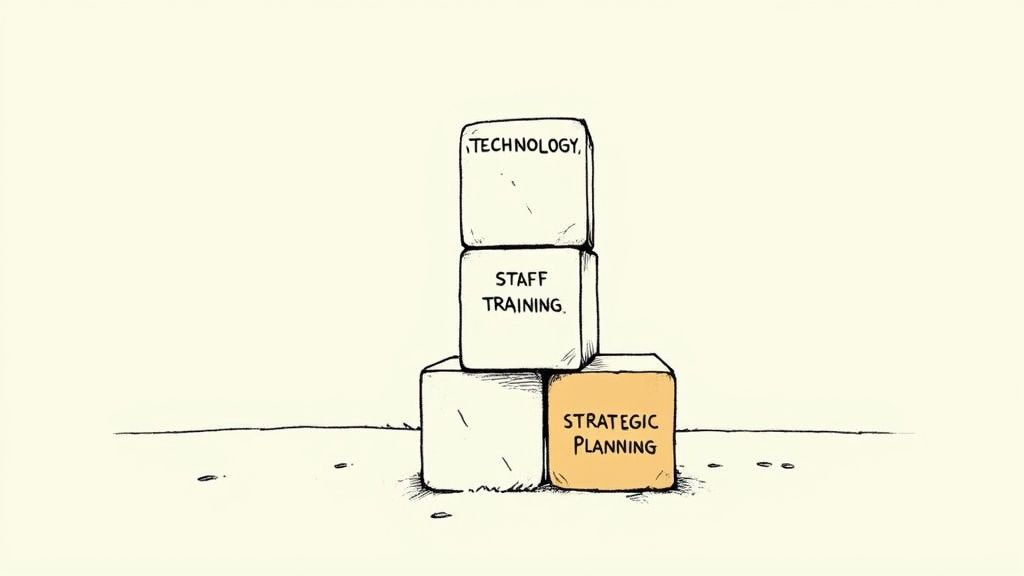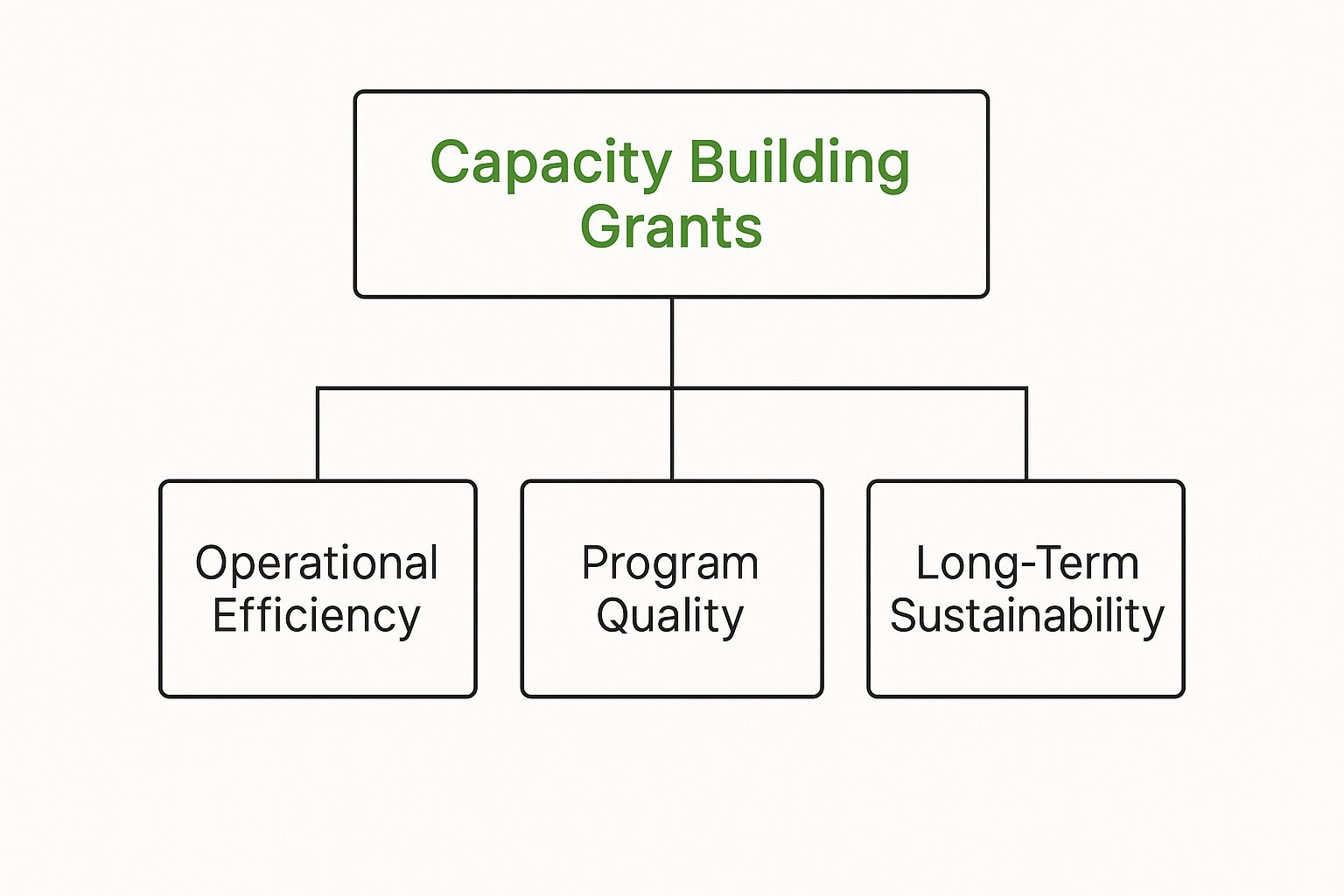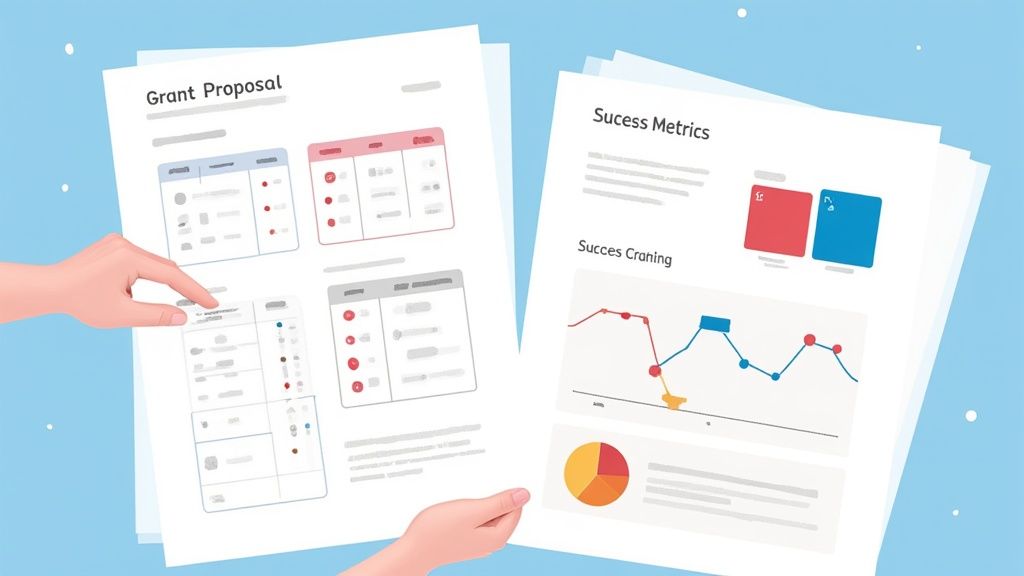Nonprofit Capacity Building Grants | Boost Your Organization
Discover top nonprofit capacity building grants and learn how to secure funding. Take your organization to the next level today!

If you've ever worked in a nonprofit, you know the constant pressure to keep program-specific funding coming in. Most grants are earmarked for direct services—buying food for the pantry, funding a specific workshop, or purchasing supplies for an after-school art class. That's all crucial work, but it doesn't pay for the very things that make that work possible.
Think of it this way: a typical grant helps you buy fish to feed people today. A capacity building grant, on the other hand, helps you build a stronger boat and better fishing nets so you can feed more people, more effectively, for years to come. It’s funding that focuses on how you do your work, not just what you do.
What Are Nonprofit Capacity Building Grants

While most grant money is restricted to front-line activities, it often leaves a critical gap. It doesn't cover the systems, training, and tools that keep your organization healthy, efficient, and ready to grow.
That's exactly where nonprofit capacity building grants step in. This is funding specifically designed to strengthen your organization from the inside out. Instead of paying for a single program, this money improves your ability to deliver all your services better.
Shifting Focus from Programs to People and Processes
Capacity building is all about reinforcing the pillars that hold up your mission. Grantmakers who offer this kind of support understand a fundamental truth: strong internal operations aren't just "overhead." They are a direct investment in your long-term impact. This type of funding is a key part of a healthy, diverse financial strategy, which you can read more about in our guide to the different sources of funding for nonprofits.
So, what can you actually use this money for? It’s surprisingly flexible. Common uses include:
- Technology Upgrades: Finally getting that new CRM you’ve needed for years or replacing ancient staff computers.
- Staff Development: Sending your team to leadership training or paying for professional certifications.
- Strategic Planning: Hiring an experienced consultant to guide your board through a new strategic plan.
- Operational Efficiency: Overhauling your financial systems or investing in volunteer management software.
The core idea is simple: a stronger organization delivers a stronger mission. By investing in your internal capabilities, you create a ripple effect that amplifies the impact of every other dollar you receive.
A Growing Trend in Philanthropy
For a long time, the focus was almost exclusively on programmatic grants. But the tide is turning. There's a growing recognition among funders that organizational health is paramount. They’re realizing that one of the best ways to guarantee a return on their investment is to fund the core strength of the nonprofits they believe in.
This isn't just wishful thinking; the data backs it up. Capacity building grants now account for about 8.9% of the largest nonprofit awards. This signals a real shift in mindset, with funders moving beyond just backing projects and starting to back potential. Savvy nonprofits are learning how to make the case for capacity building grants and winning the support they need to build lasting resilience.
How These Grants Can Reshape Your Nonprofit
When you land a capacity building grant, you're doing more than just funding a project. You're making a deep, foundational investment in your nonprofit's future. Think of it less like buying a new set of tires for a car and more like upgrading the entire engine. It’s a move that creates a powerful ripple effect, strengthening every single thing you do.
This kind of strategic funding directly boosts your operational efficiency. Imagine your team finally free from wrestling with clunky, outdated software or drowning in manual data entry. With upgraded tech, better processes, or new training, those administrative headaches disappear. Suddenly, your staff has more time and energy to focus on what truly matters: serving your community.
Building an Organization That Lasts
A solid internal structure makes your organization far more resilient. When you're not held together by patchwork systems and last-minute fixes, you're less vulnerable to sudden funding shifts or key staff members moving on. At its core, capacity building is all about sustainability.
Investing in leadership development means you have a succession plan ready to go. Creating a multi-year strategic plan gives you a clear roadmap that guides tough decisions and builds donor confidence. You’re building an organization that isn't just surviving from one year to the next but is actually positioned to thrive for decades.
This infographic really captures how these grants set off a chain reaction of positive effects, starting with your internal operations and ultimately leading to long-term impact.

As you can see, shoring up your core functions isn't just an internal goal—it's the critical first step toward making a bigger difference and ensuring your stability for the long haul.
Delivering Better Programs and Services
At the end of the day, a stronger organization delivers a better experience for the people it serves. The link between your internal capacity and your external impact couldn't be more direct.
For example, a grant for new volunteer management software does more than just simplify scheduling. It helps you keep volunteers engaged and happy, which means more consistent, high-quality support for your clients. In the same way, funding for staff training on trauma-informed care immediately elevates the quality of service you provide to vulnerable populations.
Capacity building isn't overhead—it's mission fuel. Every dollar invested in your organization's core strength directly magnifies the quality and reach of your programs, helping you make the biggest possible impact.
When you ask a funder for a capacity building grant, you're not just requesting money for behind-the-scenes improvements. You're showing them you're serious about excellence and long-term stability. You're making the case that you are a reliable partner in creating lasting community change—an organization that is truly built to last.
What Do Capacity Building Grants Actually Fund?

The term "capacity building" can sound a bit vague, but the projects it funds are incredibly practical. This isn't just "overhead" funding in disguise. Instead, think of these grants as targeted investments that fortify the very core of your nonprofit.
When you understand the common funding categories, you can better identify your organization's weak spots and frame your needs in a way that resonates with grantmakers. At their heart, nonprofit capacity building grants are designed to strengthen your internal systems, support your people, and sharpen your strategy. Let's dig into what that looks like in the real world.
Common Categories of Capacity Building Funding
To help you visualize where this funding goes, here's a breakdown of the most common areas grantmakers are willing to support.
These categories cover the essential, behind-the-scenes work that enables your nonprofit to deliver on its mission day in and day out.
Leadership and Professional Development
Any seasoned nonprofit leader will tell you their people are their greatest asset. Funders get this, and they're often excited to invest in the growth of your team, from the board room to the front lines.
This could mean funding one-on-one coaching for your Executive Director to help them navigate a tough transition. It might look like a grant for a board development workshop on fundraising best practices or providing specialized training and certifications for your program staff. This kind of investment boosts morale, prevents burnout, and ensures your team is ready for whatever comes next.
Technology and Infrastructure Upgrades
Nothing grinds productivity to a halt faster than outdated, clunky technology. Grants in this category help you get the modern tools you need to work smarter, not harder.
Maybe your team is drowning in spreadsheets, and a new Customer Relationship Management (CRM) system from a provider like Bloomerang or Neon One would be a game-changer. Perhaps your staff is working on slow, ancient computers, or your accounting team needs better financial software. This is exactly what technology grants are for.
Investing in your technology isn't a luxury; it's a direct investment in your mission. A $15,000 grant for a new volunteer management system could easily free up hundreds of staff hours a year—time that can be poured right back into serving your community.
Strategic Planning and Evaluation
Where is your organization actually headed? And how will you know if you're making a real difference? Capacity building grants provide the dedicated time and resources to answer these make-or-break questions.
These funds often support projects like:
- Hiring an experienced consultant to guide your board and staff through a full strategic planning process.
- Developing a logic model that clearly connects your daily activities to your long-term goals.
- Investing in impact measurement tools or expertise to help you track, analyze, and communicate your program's effectiveness.
This work is absolutely vital. It helps you prove your impact to other funders and ensures that every bit of effort is pushing your mission forward with purpose and clarity.
Finding the Right Capacity Building Grants
So, you've pinpointed exactly what your nonprofit needs to get to the next level, and you know a capacity-building grant is the answer. Now comes the real work: finding the funders who believe in that vision as much as you do. It can feel like looking for a needle in a haystack, but with a smart, systematic approach, you can find the perfect match.
Finding the right nonprofit capacity building grants is all about looking in the right places. This isn't like searching for program funding, which is often a much broader category. Capacity-focused grants are usually more specific and deliberate, so you need to be, too. My advice? Always start local before you broaden your search.
Where to Begin Your Grant Search
Community foundations should be your first stop. These are funders who are deeply committed to the well-being of their own local nonprofit community. They get it—they understand that strong organizations are the bedrock of strong communities. Plus, they tend to be more approachable and relationship-focused than the big national players.
Once you've explored your local scene, start looking for funders who have a stated interest in organizational effectiveness. Keep an eye out for foundations that talk about goals related to:
- Organizational Strengthening: This is a very common way funders describe capacity building.
- Leadership Development: Perfect if you're looking to invest in your people, from staff to board members.
- Infrastructure Support: This is the keyword for funders who want to help with things like technology, systems, and equipment.
Using Grant Databases Effectively
Grant databases are incredibly powerful, but only if you know how to wield them. Just typing "grants" into the search bar will leave you buried under a mountain of irrelevant results. You have to get specific. For context, platforms like Instrumentl list over 7,000 capacity building grants in the U.S. alone, representing about $3.585 billion in funding. The median award size is around $30,000.
A classic rookie mistake is using search terms that are way too broad. Think like a funder. Instead of searching for "nonprofit funding," try "grant for strategic planning services" or "technology grant for CRM software." That kind of precision will save you countless hours.
Staying Organized and Proactive
As you start discovering potential funders, organization is your best friend. A simple spreadsheet is all you really need to track deadlines, contact info, and what each foundation cares about. If you want a more structured approach, you can check out this free grant database for nonprofits to help manage your search. Many tools also let you set up alerts for new grants matching your criteria, which is a fantastic way to stay on top of new opportunities without having to constantly check back.
At the end of the day, finding the right grant is all about alignment. You're looking for a partner, not just a check. Focus on funders whose mission truly connects with your organization's goals for long-term health and growth. That's how you ensure you're applying for the right grant, not just any grant.
Crafting a Proposal That Gets Funded

When you're asking for money to improve your internal operations, you have to think differently than you would for a standard program grant. You're not funding a food pantry or an after-school program; you're funding the engine that makes those programs run. The real trick is to show funders exactly how a new database or better staff training will directly boost your mission's impact.
The biggest hurdle is getting funders to see these requests not as boring "overhead" but as a smart investment. For instance, asking for $20,000 for reporting software might sound dry. But if you frame it as a tool that will slash reporting time by 40% and give your team back 250 hours a year to serve clients? Now you’re talking their language. For more on this, Upmetrics has some great insights on making the case for capacity building.
A truly great proposal for nonprofit capacity building grants doesn't just list needs. It tells a story of what your organization could be with the right support.
Weave a Powerful Narrative
Every good story starts with a problem. Kick off your proposal by getting right to the point: what specific challenge is kneecapping your efforts? Is your data a mess? Are your staff burning out on manual processes? Is your strategic plan gathering dust? Spell out the problem and, most importantly, how it’s hurting your ability to deliver on your mission.
Then, introduce your solution as the hero. Explain exactly how this investment will tackle the challenge you just laid out. Be specific, and use numbers whenever you can.
A Simple Story Arc for Your Proposal:
- The Challenge: "Our volunteer scheduling is a nightmare of spreadsheets and phone tag, eating up 15 manual hours a week. It’s causing scheduling mix-ups and frustrating our volunteers."
- The Solution: "A new volunteer management platform will automate everything, cutting that administrative time by over 80%."
- The Impact: "This frees up our coordinator to recruit and train 50 new volunteers. We project this will expand our program’s reach by 25% within the first year."
This clear, simple arc helps funders immediately see the incredible return on their investment.
Develop a Transparent Budget and Clear Metrics
Your budget for a capacity building grant needs to be crystal clear. Don't just throw out a line item like "Software - $10,000." Break it down. Show them the cost of the licenses, the one-time fee for data migration, and the budget for getting your team properly trained. This level of detail builds a massive amount of trust and proves you've thought this through.
Just as crucial are your metrics for success. How will you know this worked? Think beyond simple tasks like "software installed." You need to focus on the real-world outcomes.
Examples of Strong Metrics:
- Reduce the time our team spends on financial reporting by 30% within six months.
- Increase our individual donor retention rate by 15% year-over-year.
- Boost the number of board members who actively fundraise by 50% after they complete governance training.
By defining these metrics upfront, you show funders you’re serious about results and give them a clear roadmap for what to expect in your grant reports.
Putting It All Together for Maximum Impact
When you're done, your proposal should be a single, logical story that walks the reader from the problem to your solution and its ultimate community impact. Keep your tone confident and focused on the future.
For a deeper dive, our guide on writing grant proposals for nonprofits has even more detail. By showing a funder that strengthening your organization's core is one of the most effective ways to strengthen the community you serve, you’re building a case that’s almost impossible to ignore.
Answering Your Top Questions About Capacity Building Grants
Diving into the world of capacity building grants can feel a little disorienting, especially if your team is used to chasing funding for specific programs. It’s a completely different mindset when you shift from funding your work to funding the way you work.
Let’s tackle some of the most common questions that come up. Getting these cleared up will help you move forward with a lot more confidence and a clearer strategy.
Are Small or New Nonprofits Actually Eligible?
This is a big one, and I get it. The good news? The answer is a definite yes. In fact, many funders create capacity building grants specifically for smaller or newer nonprofits. They know that this early stage is precisely when you need to build the strong foundation you'll rely on for years to come.
Sure, some of the huge national foundations might want to see a long track record, but plenty of others focus on helping newer organizations get the very systems they need to grow and thrive. Keep an eye out for grants focused on "organizational effectiveness" or "leadership development," as these are often a perfect fit. The lesson here is to always read the fine print, but never count yourself out just because you're small.
How Do We Show a Funder That This "Internal" Project Was a Success?
This is where you have to think a little differently. You can't just count the number of people served. Instead, you need to track both outputs (the immediate, tangible things you did) and outcomes (the real, long-term changes that happened because of your work).
Think of it like this: An output is, 'We trained 15 staff members on new project management techniques.' The outcome is the good stuff: 'Over the next year, we saw a 25% drop in missed deadlines.' That second part is what shows the funder their investment truly paid off.
Here’s another example, this time for a technology grant:
- Output: We installed and trained everyone on our new volunteer management software.
- Outcome: We saw a 30% jump in how many volunteers stayed with us and cut the admin time spent on scheduling by 40%.
Laying out these specific, measurable goals in your proposal from the start is absolutely critical. It shows the funder you’re serious about getting a real return on their investment, not just buying a new piece of software.
Can We Apply for Both Capacity Building and Program Funding at the Same Time?
Yes, you can and you absolutely should! It’s a smart and common practice to pursue both types of funding simultaneously, sometimes even from the same foundation. Grantmakers often see this as a sign of a well-run organization—they get that powerful programs need strong infrastructure to back them up.
It’s completely fine to have a program grant application out with one funder and a capacity building request in with another. The key is simply to be transparent and make sure each proposal is tailored specifically to that funder’s interests. A healthy nonprofit needs fuel for its programs and a strong engine to power them, and your fundraising strategy should reflect that reality.
At Fundsprout, we believe that strong infrastructure is the key to unlocking your mission's full potential. Our AI-powered platform helps you find the right capacity building grants, craft compelling proposals that tell your story of impact, and manage deadlines with ease, so you can focus on building a resilient organization. Discover your next funding opportunity at https://www.fundsprout.ai.
Try 14 days free
Get started with Fundsprout so you can focus on what really matters.
